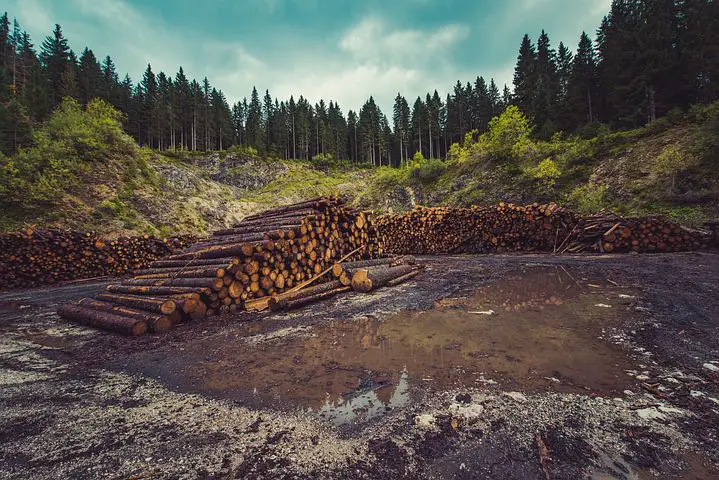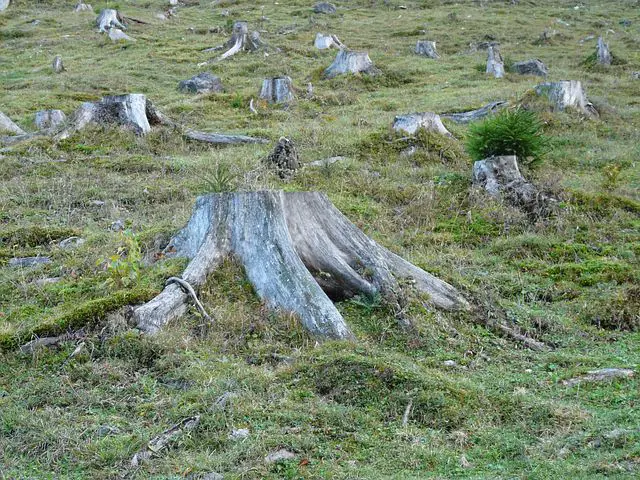DEFORESTATION: CAUSES, EFFECTS, CONSEQUENCES, AND SOLUTIONS
Afforestation means growing more and more trees. Trees are very important. They give us many amenities. If we to live happily, we have to preserve our forests. Who does not desire a lot of greenery around him or her? Isn’t it very nice to sit under a shady tree on a very hot day? Sometimes you may have seen huge trees lined on each side of the road. It is very cool to travel on such a road. Unfortunately, we often see people cutting down trees. What happens when trees are cut down? That is what this chapter tells you. Let us read the text to find out.
Forests are an important part of our life. It provides invaluable products such as industrial wood and fuelwood. Forests also provide a range of services like soil generation, soil and water conservation, purification of air and water, nutrient recycling, maintenance of biodiversity, providing a habitat for animals, mitigation of climate change and absorption of carbon. But forests are being destroyed due to several factors. The destruction of forests is usually in response to the need for more land for growing crops and rearing livestock and results in the creation of completely new ecosystems. Deforestation involves the cutting down, burning and damaging of forests. It is the permanent destruction of indigenous forests and woodland.

Causes of Deforestation
A variety of causes lead to deforestation. The world is becoming so densely populated in some places that forests are having to be cleared to make room for more recreational and living space. As human population size increases, larger areas of land have to be cultivated to supply food. In addition, cutting trees for fuel will lead to further deforestation.
The development of cash crops and cattle ranching is another reason for deforestation. In some forests, commercial logging for tropical hardwood such as teak and mahogany also leads to deforestation.
Impact of Deforestation
Clearing of forests affects local communities, who lose their source of food, fuel, construction materials, medicines and areas of livestock grazing. Forests act as watersheds. Here they catch large amounts of rain. An intact forest canopy softens the impact of intense rainfall in many ways. It releases large amounts of water back to the atmosphere by evaporation and transpiration and Channels water gently through the vegetation to the soil. Infiltration into the soil is high and there is a long delay before water flows into the streams and rivers. If the forest canopy is removed, the soil surface bakes hard in the intense heat. Rainfall cannot easily penetrate the surface and is rapidly lost from the area in the surface run-off. Thus when the forest disappears, there is no regulation of the flow, into rivers. As a result, floods and droughts alternate in the affected areas.
Deforestation exposes soil to wind, evaporation, and erosion. Soil fertility goes down due to the rapid leaching of essential mineral nutrients. The topsoil is eroded and this accelerates siltation in dams, rivers, and the coastal zone. The increased sedimentation harms downstream fisheries. Tree removal on steep slopes with shallow soil increases the risk of landslides.
Removal of forests also leads to desertification. This is a general term for the degradation into dry land areas so that formerly productive land becomes useless.

Alternatives / Solutions
An important alternative to deforestation is afforestation. It involves the planting of more trees The Union and State governments have launched several afforestation programs The Social Forestry Programme sees the use of public and common land to produce firewood, fodder, and timber for the use of rural community. Urban foresty Programme consisting of planting trees in urban areas has also helped in building forests. People’s movements like the Chipko Movement has done much to prevent deforestation. Another proposed solution for deforestation is to reduce the consumption of forest-based products. Alternatives are introduced which includes the use of the world’s forests in such a way that they continue to provide resources in the present, without depriving future generations of their use.
Future of World’s Forests
Forests are being destroyed due to a variety of factors and it is going to be very difficult to save them. None of the remaining forests of the world are free from intervention. The loss of forests is, however, only a symptom of deeper and possible unstoppable degradation of the Earth’s environment.
Ask Your Question?
Meanings and Explanations
When the essay opens you are introduced to the topic. You are told about the importance of forests and about deforestation in general:
invaluable: for which value cannot be fixed; priceless
soil generation: synthesis of soil or production of soil
conservation: preservation or protection of soil and water
biodiversity: different forms of plants and animals
habitat: living place
mitigation: make milder
factors: reasons
livestock: farm animals (the cattle)
indigenous: belonging naturally to a place (native to region)
The causes of deforestation and enlisted here.
densely populated: thickly populated
cattle ranching: cattle breeding
logging: cutting and preparing timber
teak and mahogany; names of trees
We have just gone through the causes of deforestation. Now we shall see what happens due to deforestation.
Forests act as water reservoirs: They collect and conserve a large amount of rainwater. Forests act as watersheds.
intact, forest canopy: entire forest cover formed of the uppermost layer of leaves of trees.
evaporation: loss of water as vapour into the atmosphere
transpiration: loss of water as vapour from the surface of the leaves
infiltration: penetrate into or enter
intense: severe
surface runoff: flow away or flow off along the surface
leaching: removal
siltation: formation of silt or sediments (broken down fragments of rocks or any matter that accumulates in the bottom of a liquid)
sedimentation: formation and accumulation of sediments
landslide: sliding down of a mass of land from a mountain
Greenhouse effect: The earth’s atmosphere contains 0.03% Carbon Dioxide. Due to several reasons like pollution, deforestation, etc. the amount of Carbon Dioxide in the atmosphere increases. This results in the trapping of heat near the earth’s surface, This trapping of sun’s heat in the lower atmosphere due to high levels of Carbon Dioxide is called the greenhouse effect.
regional: of a particular region
Degradation: lower in grade; reduction in level or quality
fragmentation: the process of breaking into pieces or fragments
desertification: formation of deserts
Are there alternatives to deforestation? The paragraph you are going to read tells you about the alternatives to deforestation.
solution: answer
resource: stock or supply that can be drawn on
depriving: dispossessing
fodder: dried hay or straw for cattle
We have come to the end of the essay If we are not careful about our forests we are going to be in deep trouble.
intervention: Comprehension of the act of interfering in other’s state of affairs.
Short Answer Questions
1. Why are forests called an important part of our life?
A: Forests provide invaluable products such as industrial wood and firewood. Forests also provide a range of services like soil generation, soil and water conservation, purification of air and water, etc.
2. What is meant by deforestation?
Ans. Deforestation is the cutting down, burning or the permanent damaging of forests.
3. Why are forests being destroyed?
Ans. Forests are being destroyed to get more land for recreational and living space. It is also destroyed to grow crops and rear livestock and to gather fuel. Development of cash crops, cattle ranching and cutting trees for hardwood also causes deforestation.
4. What does destruction of forests lead to?
Ans. Destruction of forests leads to the creation of completely new ecosystems.
5. What are the causes of deforestation?
Ans. Forests are cleared to get more land for recreational and living space to grow crops, rear livestock and to gather fuel. Development of cash crops, cattle ranching and cutting trees for hardwood. also causes deforestation.
6. How does clearing of forests affect local Communities?
Ans. Local communities lose their source of food, fuel, construction materials, medicines and areas of livestock grazing.
7. How do forests act as watershed?
Ans. Forests act as a watershed by catching large amounts of rain.
8. What does an intact forest canopy do?
Ans. An intact forest canopy softens the impact of intense rainfall. It channels water gently through the vegetation to the soil and therefore infiltration to the soil is high.
9. What happens when the forest canopy is removed?
Ans. When the forest canopy is removed the soil surface becomes hard in the heat. Thus rainwater cannot get into the surface and is lost in surface runoff. Water flow into the river is also not regulated resulting in flood or drought.
10. What happens When the soil is exposed?
Ans. Evaporation of moisture and soil erosion leads to the loss of soil fertility due to leaching of essential mineral nutrients.
11. What happens When the top soil is eroded?
Ans. It accelerates siltation in dams, rivers, and coastal zones. This harms downstream fisheries and increases the risk of landslides.
12. How is increase in carbon dioxide harmful?
Ans. It is a major contributor to the green house effect. Through the green house effect, the earth becomes more and hotter.
13. How does deforestation affect the climate?
Ans. It reduces the evaporated cooling that takes place from both soil and plant life. The rainfall pattern may also be affected.
14. What happens to wild life due to deforestation?
Ans. Many species of plants and animals become extinct. Many genetic varieties are lost.
15. How are deserts formed?
Ans. Removal of forests leads to the formation of deserts. The dry land area becomes degraded so that productive land becomes useless.
16. What is afforestation?
Ans. The process of planting trees is called afforestation.
17. What is Social Forestry Programme?
Ans. It is a programme where the public and common land is used to produce firewood, food, and timber for the use of local community.
18. How has Urban Forestry programme helped in building forests?
Ans. Urban Forestry Programme has helped in building forests by planting trees in urban areas.
19. What are the alternatives to deforestation?
Ans. The reduction of the consumption of forest-based products and planting of more trees is a way of reducing deforestation.
20. What is the loss of forests a symptom of?
Ans. The loss of the forest is a symptom of deeper and possibly unstoppable degradation of the Earth’s environment.
Paragraph Questions and Answers
1. What is the importance of forests?
Answer: The forests are an important part of our life. We get different products like industrial wood and firewood from the forests. The forests help in producing the soil and conserving soil and water. It also supports the purification of air and water. Different varieties of plants and animals find shelter in the forests. The forests also help in the mitigation of climate change and the absorption of carbon.
2. Why are forests being destroyed? OR
3. What are the causes of deforestation?
Answer: As the population increases, more space is needed to live and for recreation. Food production should also increase. People use the forests to gather firewood. Development of cash crops and cattle ranching is another reason for deforestation. Sometimes trees are cut in large numbers for timber. This also contributes to deforestation.
4. What is the impact of deforestation?
Answer: When forests are cleared the local communities lose their source of food, fuel, construction materials, medicines, and livestock grazing. When there are no forests, there is no regulation of the flow of water into rivers. Also, rainfall does not penetrate into the soil. All this causes flood and drought. Soil is exposed to evaporation and erosion. Essential materials are lost and landslides occur. The burning of trees increases the carbon dioxide level which will lead to green house effect. The climate is affected. Many species of animals and plants become extinct. This will also lead to the formation of deserts.
5. What are the alternatives to deforestation?
Answer: One alternative to deforestation is to plant more trees. This is called afforestation. The union and state governments have launched several afforestation programmes. Another alternative is to reduce the consumption of forest-based products. The world’s forests should be used economically such that the forests will continue to provide resources in the present and for the future. Peoples movements like the Chipko Movement has done much to prevent deforestation.
Ask Your Question?




